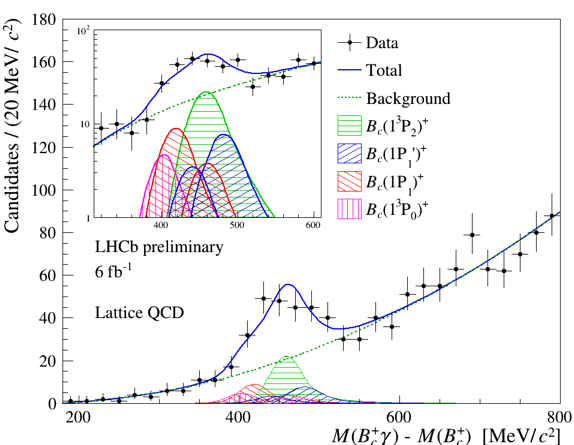At a CERN seminar today, the LHCb collaboration announced the first observation of orbitally excited Bc+ states, which are composed of a beauty-charm quark-antiquark pair. Within the expected mass range for excited 1P-wave Bc+ states a wide peaking structure was observed in the Bc+γ mass spectrum.
The simultaneous discovery of the first heavy quark-antiquark bound state, the J/ψ, at Brookhaven and SLAC in November 1974 brought a revolutionary change to the landscape of particle physics. The beauty-antibeauty bound state, Υ, was discovered in 1977 at Fermilab. Charm and anti-charm quarks, as well as beauty and anti-beauty quarks, are bound in various quantum states called charmonium and bottomonium, respectively. These states are analogous to the different quantum states of the hydrogen atom.
The Bc+ meson has a mass which is intermediate between the J/ψ and Υ masses. Beauty and charm quark-antiquark pairs are also bound in various quantum states, in a manner similar to charmonium and bottomonium systems. The ground state of the Bc+ was discovered at the Tevatron in 1998. To date only the second S-wave excited state, the Bc(2S), has been observed at the LHC. It was first reported by the ATLAS collaboration as a broad peak in the Bc+π+π– mass spectrum, and later resolved into two narrow peaks by the CMS and LHCb collaborations.

As the total spin of the beauty and charm quarks in the meson can be either zero or one, it is expected that there will be four orbitally excited (1P) states with an orbital angular momentum of L = 1. LHCb physicists searched for their radiative decays to the Bc+ ground state, Bc(1P)+→ Bc+γ. The Bc+ was reconstructed from the Bc+→J/ψπ+ decay, with the J/ψ meson formed from a pair of oppositely charged muons. The distribution of the mass difference M(Bc+γ)-M(Bc+) is shown in the image above. The inset shows the mass distribution of the Bc+ mesons.
A wide, clearly visible peaking structure is evident in the M(Bc+γ)-M(Bc+) mass difference with a statistical significance greater than seven standard deviations. Using a simple model, the visible width of the structure is approximately 37 MeV/c2 which is significantly larger than the expected resolution of about 20 MeV/c2 under the single-peak hypothesis. Therefore at least two peaks are required to describe the data. A good fit quality is achieved using a two-peak model, where both peak locations are varied during the fitting process. The mass distribution and the fit result are shown in the image above. The locations of the two peaks are m1 = 6704.8 ± 5.5 ± 2.8 ± 0.3 MeV/c2 and m2 = 6752.4 ± 9.5 ± 3.1 ± 0.3 MeV/c2.
The production cross-section of the Bc(1P)+ states relative to that of the Bc+ is also measured in the LHCb fiducial region at √s=13 TeV to be 0.20±0.03±0.02±0.03. This result is based on a theory-constrained six-peak model. The fit result according to lattice QCD predictions is shown in the image on the left as an example.
These results expand the scope of hadron spectroscopy and are crucial for advancing our understanding of the internal dynamics of hadrons and the non-perturbative properties of QCD. For more information, see the LHCb seminar presentation and the forthcoming paper.

